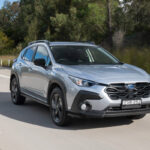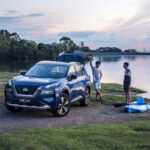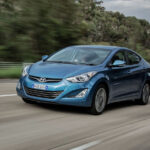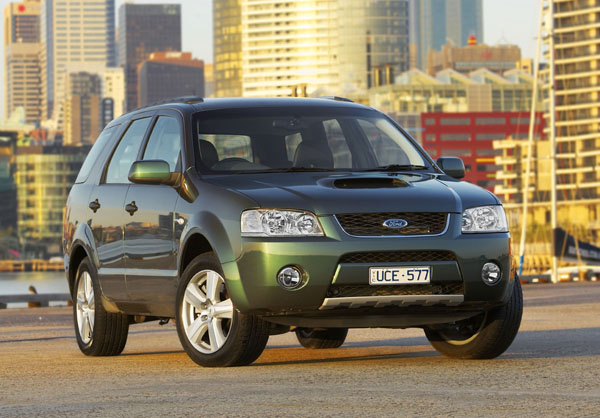
2006 Ford Territory
Ford Territory is a large SUV that was designed and built in Australia. Launched in May
2004 It was based on the Ford Falcon and shares some of its mechanical components
however, many parts are unique to the big wagon.
This Ford SUV has precise handling for an off-road wagon and rides better than many
European SUVs which cost considerably more.
The big Ford wagons are holding their value well because serious off-road drivers are
aware that every other SUV sold in Australia is an overseas design. These may -or may
not – have been adapted to suit Australian driving conditions.
Ford Territory seating is for five or seven people according to the number of rows of seats.
The third row of seats isn’t too bad for adults, but a more realistic passenger load is four
adults and three children.
Luggage space with five seats is good, but with all seven seats in use there’s obviously not
a lot of room left.
Territory received a major revamp in May 2011. Significant changes were made to ride
comfort and handling, with less body roll than the original. NVH (noise, vibration,
harshness) was almost to sedan standards, thanks to highly experienced Aussie
engineers giving it their best work.
In December 2014 the Territory got a facelift. It also saw the introduction of a Ford’s in-car
connectivity system, SYNC2, standard across the range, as well as WiFi hotspot and voice
control smart technology.
But it was too late for Ford’s 10-year-old SUV to compete with much newer imports and
the last Territory was built in October 2016.
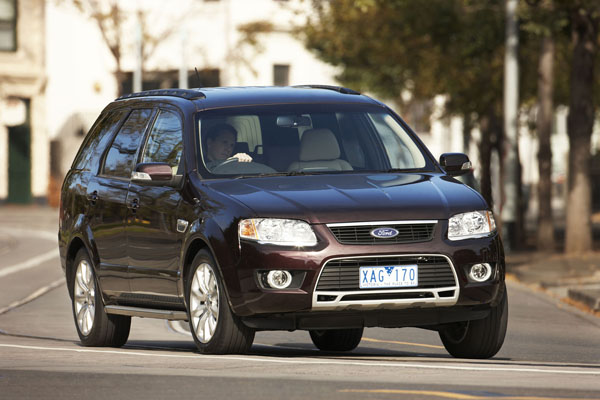
2009 Ford Territory
Territory isn’t as large as it appears, being significantly shorter than a Falcon station
wagon and, surprisingly, also shorter than a Falcon sedan. Meaning that the Territory
easier to drive and park than you might expect.
Most Ford Territorys have Ford’s old-faithful straight-six 4.0-litre petrol engine, with a
turbocharged version of this six being offered from July 2006. The engines are on the
thirsty side, but were improved slightly over the years. The six-speed petrol autos are
noticeably more economical than the four-speeders.
The long-overdue option of a turbo-diesel engine was introduced in the facelifted Territory
of 2011. A 2.7-litre V6 it has used the latest technology in variable-vane turbos and high-
pressure injection.
All Territorys have automatic transmissions, four-speed until October 2005, when a six-
speed was introduced on the upmarket Ghia, but only in AWD format. The six-speed was
gradually moved into other models, but it wasn’t until the 2011 makeover that it was finally
used in all Territorys.
The automatic six is the only transmission installed in the turbo-petrol and diesel powered
Territorys.
Territory is sold with two-wheel-drive (to the rear wheels), or all-wheel drive. Electronic
aids improve traction off-road in the Ford Territory 4WD variants. Hill-descent and hill-start
assistance take much of the scariness out of extreme slopes.
Though there’s good underbonnet and under-vehicle access, this is a modern vehicle
that’s complex in its mechanical components. So, unless you are an expert it’s best to
leave all but the simplest of maintenance to the trained mechanics.
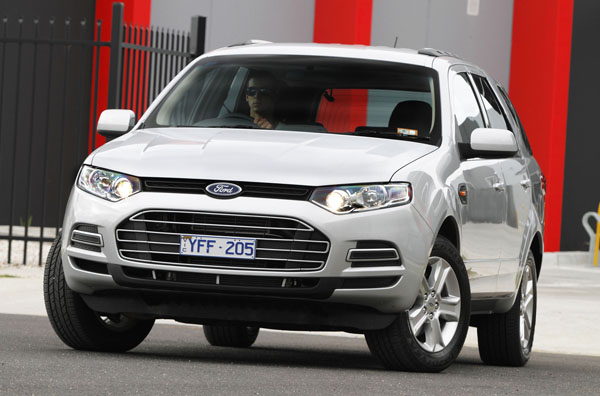
2014 Ford Territory
Virtually every town of any significance has a Ford dealership, and many private garages
will have a mechanic or two who was trained in a Ford workshop.
Spare parts for the Territory are generally favourably priced and as yet we haven’t heard of
any recurring complaints about availability.
Insurance premiums are usually in the lower end of the scale and there doesn’t seem to be
a big variance from company to company.
WHAT TO LOOK FOR
Territory is built to a reasonably high standard in Geelong. We do see the occasional
problems so a professional inspection is recommended after you have done your own
initial look over.
Take a Territory for a run on rough roads to see if there are any rattles or squeaks as
cabin parts rub against one another. Even the 2WD models are sometimes used to
explore bush tracks and the like.
Look at the condition of the body in case the Territory has been in off-road territory. Signs
of the latter damage are generally at the bumper corners, the underneath of the door sills
and on the underbody. Also look for tiny scratches in the body side where it has been
squeezed through the undergrowth.
Check the engine starts up easily and idles smoothly and quietly.
Make sure the automatic transmission doesn’t hold onto gears, or change gears too often
when it really should be holding the one ratio.
Possible leaks at front brake hoses were the subject of a voluntary recall in March 2009.
Check with a Ford dealer or the company’s head office to see if the work has been done.
Visually check the condition of the interior, including the luggage area. Off-road exploring
with lots of gear and muddy people on board can result a mess, even trim damage.
CAR BUYING TIP
Looking for a hard-working vehicle to use in the bush? It’s hard to go past any one that’s
designed and built for Oz.
RECALLS: To browse recalls on all vehicles go to the ACCC at:
www.productsafety.gov.au/products/transport/cars/




